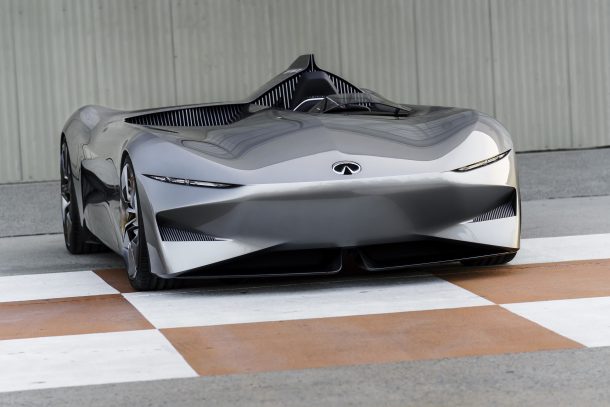Infiniti Teases Electric SUV Destined for Detroit Debut

Infiniti will unveil a new concept previewing its first electric car at the North American International Auto Show next month. On Friday, Nissan’s luxury division released a digitally shrouded image of the model to help build anticipation.
While Infiniti spent much of the past year showcasing interesting concept vehicles, precious few have a snowball’s chance in hell of reaching production. Instead, the autos served as an opportunity for Infiniti to dabble in a new design language while simultaneously proving that it hasn’t forgotten about electrification. Last January, the company showcased the Q Inspiration, announcing it would electrify its entire portfolio from 2021 onward, using either e-Power or pure EV powertrains. Seven months later, it unveiled the Prototype 10 at Monterey Car Week — which it said solidified the look of upcoming models, especially those of the electric persuasion.
While this upcoming crossover appears to do much of the same, there’s a chance it might be a precursor for a vehicle that might someday reach the showroom.
Rumored to be roughly the size of the QX30, nothing is known about its powertrain other than its fully electric status. Infiniti claims its platform is new, allowing for a “lounge-like interior,” in addition to an unspecified list of “welcoming and assistive technologies.”
We assume it’ll be the first vehicle to preview the new modular platform that will eventually underpin the majority of Infiniti’s fleet. The proposed vehicle architecture was announced earlier this year and is expected to bear fruit by 2021, when the brand launches its first battery electric vehicle. Considering current market trends, it would make sense for Infiniti to make it a crossover. This might not be the official template for that model, though it will almost certainly lay amount of groundwork for it.
“The concept car we will show in Detroit is the beginning of a new era for Infiniti, and an illustration of where we want to go with the brand. Electrification and other new technologies have given us the opportunity to evolve our design philosophy,” said Karim Habib, Executive Design Director for the brand.
[Image: Infiniti]

A staunch consumer advocate tracking industry trends and regulation. Before joining TTAC, Matt spent a decade working for marketing and research firms based in NYC. Clients included several of the world’s largest automakers, global tire brands, and aftermarket part suppliers. Dissatisfied with the corporate world and resentful of having to wear suits everyday, he pivoted to writing about cars. Since then, that man has become an ardent supporter of the right-to-repair movement, been interviewed on the auto industry by national radio broadcasts, driven more rental cars than anyone ever should, participated in amateur rallying events, and received the requisite minimum training as sanctioned by the SCCA. Handy with a wrench, Matt grew up surrounded by Detroit auto workers and managed to get a pizza delivery job before he was legally eligible. He later found himself driving box trucks through Manhattan, guaranteeing future sympathy for actual truckers. He continues to conduct research pertaining to the automotive sector as an independent contractor and has since moved back to his native Michigan, closer to where the cars are born. A contrarian, Matt claims to prefer understeer — stating that front and all-wheel drive vehicles cater best to his driving style.
More by Matt Posky
Latest Car Reviews
Read moreLatest Product Reviews
Read moreRecent Comments
- V8fairy Not scared, but I would be reluctant to put my trust in it. The technology is just not quite there yet
- V8fairy Headlights that switch on/off with the ignition - similar to the requirement that Sweden has- lights must run any time the car is on.Definitely knobs and buttons, touchscreens should only be for navigation and phone mirroring and configuration of non essential items like stereo balance/ fade etc>Bagpipes for following too close.A following distance warning system - I'd be happy to see made mandatory. And bagpipes would be a good choice for this, so hard to put up with!ABS probably should be a mandatory requirementI personally would like to have blind spot monitoring, although should absolutely NOT be mandatory. Is there a blind spot monitoring kit that could be rerofitted to a 1980 Cadillac?
- IBx1 A manual transmission
- Bd2 All these inane posts (often referencing Hyundai, Kia) the past week are by "Anal" who has been using my handle, so just ignore them...
- 3-On-The-Tree I was disappointed that when I bought my 2002 Suzuki GSX1300R that the Europeans put a mandatory speed limiter on it from 197mph down to 186mph for the 2002 year U.S models.




































Comments
Join the conversation
Looking forward to a sedan or fastback version of this.
Great jack-o-lantern face. Gives me ideas for next Halloween: leave out logos and letters; see who can name the travesty.